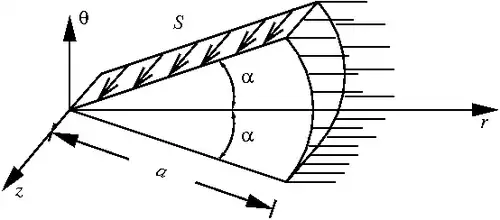Solution
Step 1: Identify boundary conditions

The traction boundary conditions in terms of components of the stress tensor are

Step 2: Assume solution
Assume that the problem satisfies the conditions required for antiplane shear. If  is to be uniform along
is to be uniform along  , then
, then

or,

The general form of  that satisfies the above requirement is
that satisfies the above requirement is

where  ,
,  ,
,  are constants.
are constants.
Step 3: Compute stresses
The stresses are

Step 4: Check if traction BCs are satisfied
The antiplane strain assumption leads to the  and
and  BCs being satisfied. From the boundary conditions on
BCs being satisfied. From the boundary conditions on  , we have
, we have

Solving,

This gives us the stress field

Step 5: Compute displacements
The displacement field is

where the constant  corresponds to a superposed rigid body displacement.
corresponds to a superposed rigid body displacement.
Step 6: Check if displacement BCs are satisfied
The displacement BCs on  and
and  are automatically satisfied by the antiplane strain assumption. We will try to satisfy the boundary conditions on
are automatically satisfied by the antiplane strain assumption. We will try to satisfy the boundary conditions on  in a weak sense, i.e, at
in a weak sense, i.e, at  ,
,

This weak condition does not affect the stress field. Plugging in  ,
,
![{\displaystyle {\begin{aligned}0&=\int _{-\alpha }^{\alpha }u_{z}(a,\theta )d\theta \\&={\frac {Sa}{2\mu }}\int _{-\alpha }^{\alpha }\left(-{\frac {\cos \theta }{\sin \alpha }}+{\frac {\sin \theta }{\cos \alpha }}+C{\frac {2\mu }{Sa}}\right)d\theta \\&={\frac {Sa}{2\mu }}\int _{-\alpha }^{\alpha }\left(-{\frac {\cos \theta }{\sin \alpha }}+{\frac {\sin \theta }{\cos \alpha }}+C{\frac {2\mu }{Sa}}\right)d\theta \\&={\frac {Sa}{2\mu }}\left[\left(-{\frac {\sin \theta }{\sin \alpha }}-{\frac {\cos \theta }{\cos \alpha }}+C\theta {\frac {2\mu }{Sa}}\right)\right]_{-\alpha }^{\alpha }\\&={\frac {Sa}{2\mu }}\left(-2{\frac {\sin \alpha }{\sin \alpha }}+2C\alpha {\frac {2\mu }{Sa}}\right)\\&=-{\frac {Sa}{\mu }}+C\alpha \end{aligned}}}](../64f47883f95bad7a1aaeb0bbe49a68144f177177.svg)
Therefore,

The approximate displacement field is

